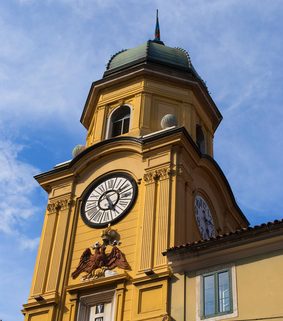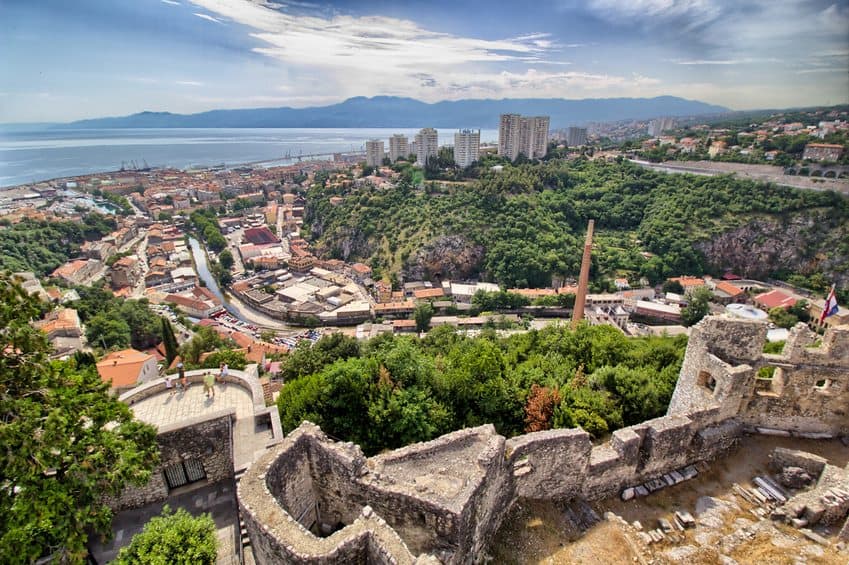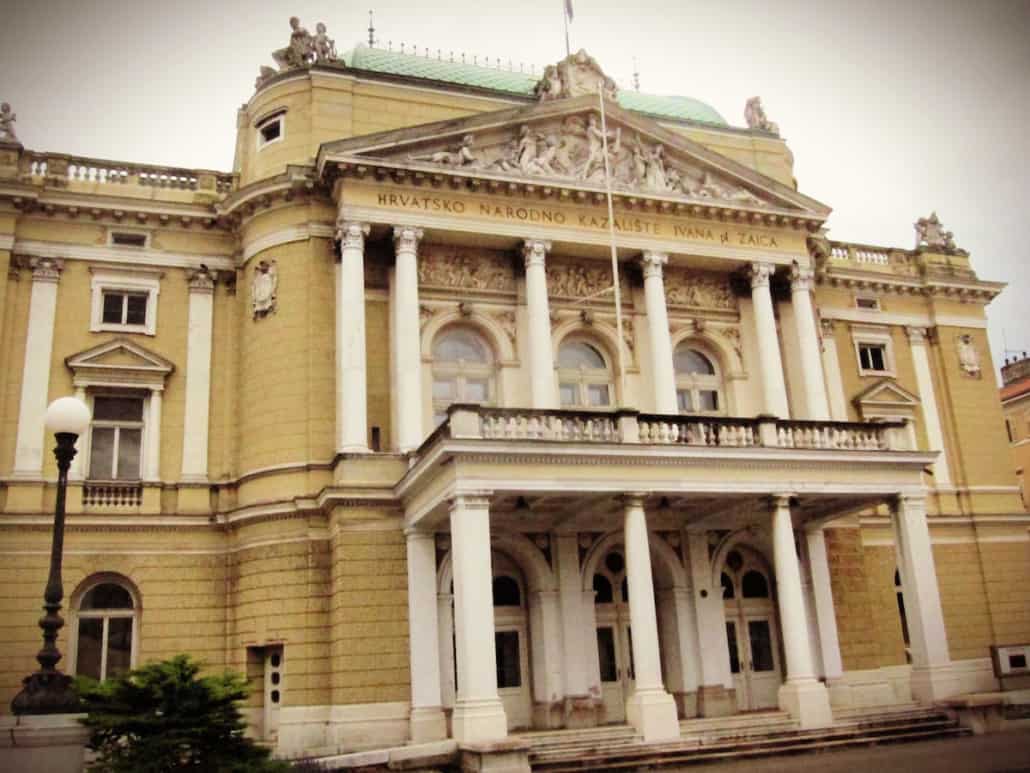
The Kvarner Riviera‘s largest city is Rijeka which, with a population of just over 200,000 people, is also Croatia’s third-largest city and its busiest port. The word rijeka actually means river in Croatian, as does the Italian name for the city – Fiume.
Rijeka is considered something of a transit city and with few beaches, it is not many consider it as a place to stay for a long holiday. That being said, there are a number of great sights in the city as well as plenty of cafes, restaurants, bars and shops. It’s a bustling place and close to other towns, resorts and islands should you wish to hop over to enjoy some seaside time. Rijeka is therefore still an interesting place to visit and even stay in.

Getting to Rijeka
From outside of Croatia
Rijeka Airport, on the island of Krk, is the city’s airport and there are flights to there from a handful of European cities, including London. See our Getting to the Kvarner Riviera page for more details on various flight options. If you do fly to Rijeka Airport, there are buses that meet each flight arrival that take you to the main bus station in downtown Rijeka; more details on our Getting to and from Rijeka Airport page.
There are also buses from cities in Europe to Rijeka, such as from Munich, Stuttgart, Lyon, Florence, Bologna, Milan, Venice, Trieste, Ljubljana, Vienna, Villach, Salzburg and Prague. Many of these international bus routes are operated by Flixbus.
There are some international train services to Rijeka, such as a service from Ljubljana in Slovenia. There is also now a seasonal train route from Villa Opicina near Trieste in Italy via Slovenia to Rijeka which takes just two hours. Take a look at the Die Bahn website for timetable details of international train routes.
From elsewhere in Croatia
There are regular buses and trains from Zagreb to Rijeka. Bus is actually the slightly better option – because the bus travels on the motorway, some buses only take 2 hours 15 minutes.
Arriva is one of the major bus companies in Croatia and is based in Rijeka, so see their website for timetables of routes to and from the city. There are buses between Rijeka and a number of the main destinations in Croatia.
For train timetables for internal Croatian journeys take a look at the Croatian Railways website.
Local bus timetables and routes can be looked up on the Autotrolej website.
Jadrolinija run a catamaran service connecting Rijeka with Rab island and Novalja on Pag. The same company also have a service from Rijeka to Mali Losinj, which stops on Cres and the small islands of Unije, Susak and Ilovik along the way.
History of Rijeka
Rijeka has had a very eventful past and has been ruled by many different countries and empires over the years. In its early history, Rijeka was an Illyrian settlement before becoming part of the Roman Empire in the 2nd century BC, and given the name Tarsatica.
In the Middle Ages, it was part of the Croatian Kingdom and then part of the Habsburg Empire before it was declared a free city in 1530 and a free port in 1719. Trade with the Middle and Far East helped Rijeka grow and establish itself as a port.
In 1779, Rijeka came under the control of Hungary and substantial building work was undertaken on Hungary’s international port. In the late 19th century, the first railway track was built in Croatia connecting Rijeka, through Zagreb, to Budapest and thus the importance of Rijeka grew even further. For these reasons, various industries were based in the city, including a huge ship-building yard.
After the disintegration of the Austro-Hungarian Empire in 1918, an interesting event occurred in Rijeka. The great Western powers intended to declare the city a free port under international control. However, the Italian poet and writer Gabriele D’Annunzio marched into the city with his supporters and declared it a part of Italy. Rome was reluctant to accept this, so D’Annunzio declared Rijeka a city-state. Eventually, in 1924, Mussolini annexed Rijeka. In 1947, the city became Croatian again, as part of Yugoslavia.
Sightseeing in Rijeka
The fully pedestrianised Korzo is the main street in Rijeka, with numerous shops and cafes.

On the Korzo is the City Tower (Gradski toranj in Croatian) and its four clocks which has been built over a period from the 16th to 19th centuries, with its general appearance stemming from the 18th century – the clocks are from 1784.
The Roman Arch, considered to be from the 4th century, has been the subject of some debate over the years. Linked to Emperor Claudius II, and also thought to be a triumphal arch or a city gate, it is now believed to have been part of a fortress.
The Church of St Vitus, octangonal in shape, is from the 17th century and built on the site of an older church; St Vitus is the patron saint of the city. Within the church is a crucifix from the 13th century that, legend has it, was struck by a stone thrown by a chap called Petar Loncaric in 1296 after some back luck on the cards. The earth opened up and swallowed him whole, while the crucifix began to bleed.

Ivan Zajc National Theatre (above) was built in 1885 to the design of Austrian architects Ferdinand Fellner and Hermann Helmer. Ivan Zajc was a prolific Croatian composer and conductor (and born in Rijeka); he worked at the theatre from 1855 to 1862. Details of current performances can be found at www.hnk-zajc.hr.
With free entrance, the Museum of Modern and Contemporary Art is well worth a visit for its many events and permanent and temporary modern art exhibitions.
For something a bit different, why not take a look at the Peek & Poke computer museum? With over 1,000 exihibits of computer history (consoles, computers, calculators) it’s definitely worth a visit. Open on request, contact the museum in advance to arrange a visit. Peek & Poke also opened a separate Museum of Childhood – featuring toys and games from the 19th century to the present day – in 2013.

Guided Tours of Rijeka
Take a look at some of the guided tours of Rijeka available below:
Day Trips
Arriva Travel offers a day trip to the Plitvice Lakes National Park. It’s a 12-hour round trip, and an English-speaking guide is included as part of the trip. Departure is from the main bus station in Rijeka.
Eating and Drinking in Rijeka
Nebo is an excellent fine-dining choice in the city, offering a beautifully presented tasting menu that serves up a modern twist on traditional Croatian food.
Ristorante Spagho offers Italian cuisine – obviously, lots of very tasty pasta, ravioli, gnocchi and risotto dishes as well as hearty mains – in a homely setting just a few steps away from the Korzo.
Marsecchia is a top-rated coffee shop in the city serving speciality coffee, hot drinks and other beverages in a very cosy setting.
Accommodation in Rijeka
Take a look at hotels and rentals in Croatia using the below search box and map:
Alternatively, see accommodation listings on our Accommodation in Rijeka page.
General info
The area code is 051.
The Tourist Board is located at Uzarska 14.
More information can be found at the very useful Rijeka Tourist Board website and at the City of Rijeka website.
If in Rijeka, why not pop along to the drive-in cinema at Beretich parking lot, which opened in 2020?
See our map of Rijeka.
